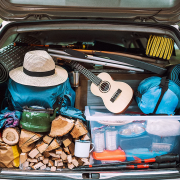Robots that can fit multiple items into a limited space could help pack a suitcase or a rocket to Mars
By Nick Hilden
Packing the car for a road trip might seem like a straightforward enough task, but it’s never been an easy one for robots to learn—until a new study turned the robot training over to artificial intelligence. The implications of this research go far beyond a well-packed trunk and could eventually impact things ranging from how we manage our homes to how we colonize Mars.
Using a form of generative AI known as a “diffusion model,” a team of researchers at the Massachusetts Institute of Technology and Stanford University trained robots to pack items into a limited space while adhering to a range of constraints: human concerns such as making sure that heavier items didn’t crush lighter ones, that some items had a certain amount of space between them, that a robot’s arm didn’t accidentally strike the container and damage it, and so on. The diffusion model helped the robots accomplish this faster than training methods used in the past, the researchers say.
“We want to have a learning-based method to solve constraints quickly because learning-based [AI] will solve faster, compared to traditional methods,” says M.I.T. Ph.D. student Zhutian “Skye” Yang, lead author of a paper detailing the study, which was recently released ahead of peer review on preprint server arXiv.org. A “learning-based” approach involves allowing an AI program to learn autonomously by identifying patterns between training data and the desired output. This differs from previously tested “rule-based” programs, which are more limited as they must behave within a strictly coded set of regulations. “The diffusion model is a very good method for sampling different solutions to a problem and jointly satisfying all of the constraints,” Yang says.
Autonomous packing “has been a challenging problem,” says Animesh Garg, an assistant professor of AI robotics at the Georgia Institute of Technology, who was not involved in the new study but works in a similar research area. “Without machine learning, the solution involves computationally intensive online 3-D bin packing”—a rule-based technique that “can even be unsolvable” depending on a program’s coded limitations.
Previously, for a robot to solve a packing problem within the aforementioned constraints, it would have to work sequentially. It would develop possible packing configurations and test each against one constraint at a time, then check for conflicts with the other constraints. This trial-and-error method proved too slow, especially when there were more items to pack—and therefore more actions to test. In the new study, the diffusion model, on the other hand, allowed a robot to simultaneously explore an array of machine-learning models, each representing an individual constraint. The sum total of these models afforded the robot a more thorough view of the problem, enabling it to consider all constraints at once, almost instantaneously. As a result, many more successful packing configurations were found faster than they had been with previous techniques. The study’s diffusion method also proved capable of solving new combinations of constraints that were applied to a larger number of items—beyond what the model experienced during training.
“Packing with robots is incredibly hard yet transformational,” Garg says. “This work enables robots to start ‘thinking’ on the fly and achieve very good, if not optimal, solutions quickly.”
“It’s a type of optimization problem,” Yang says. “With the learning-based method, we're happy to see that if we train on the small problems, it can generalize to solving problems with a larger number of objects or a larger set of constraints.”
The study team also looked at how its learning algorithm aligned with—or diverged from—most people’s intuition about how to pack. Humans “have heuristics of packing things to the edge first,” Yang says. “If you have a lot of things, you always pack them to the bottom left-hand side. Or if you are stacking things, you place things evenly, layer by layer, instead of all the way up one side and then the other.” While these heuristics may seem logical from a human perspective, learning-based robots without our preconceptions are free to discover novel solutions...
Read the full article on the Scientific American website using the link below.

